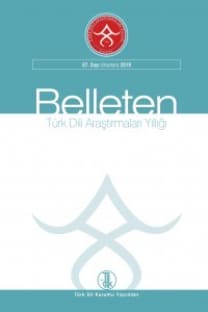ON bIdgẄčIr IN THE 3RD LINE OF THE SOUTH SIDE OF THE ŠINE-USU INSCRIPTION
Moyun Čor, spelling error, Šine-Usu Inscription, Turkic runic script, Uyghurs
___
- Ajdarov, G. (1971), Jazyk orxonskix pamjatnikov drevnetjurkskoj pis’mennosti VIII veka. Alma-Ata: Izdatel’stvo «Nauka» Kazaxskoj SSR.
- Aydın, E. (2007). Şine Usu Yazıtı. Çorum: Karadeniz Araştırmaları Merkezi.
- Aydın, E. (2011). Uygur Kağanlığı Yazıtları. Konya: Kömen.
- Bazin, L. (1991). Les systèmes chronologiques dans le monde turc ancient. Budapest: Akadémiai Kiadó.
- Berta, Á. (2004). Szavaimat jól halljátok…, A Türk és Ujgur rovásírásos emlékek kritikai kiadása. Szeged: Jate.
- Berta, Á. (2010). Sözlerimi İyi Dinleyin…, Türk ve Uygur Runik Yazıtlarının Karşılaştırmalı Yayını. E. Yılmaz (transl.). Ankara: Türk Dil Kurumu.
- Bregel, Y. (2003). An Historical Atlas of Central Asia. Leiden & Boston: Brill.
- Clauson, G. (1972). An Etymological Dictionary of Pre-Thirteenth-Century Turkish. Oxford: Claren-don.
- Dankoff, R., Kelly, J. (1982). Maḥmūd al-Kāšγarī: Compendium of the Turkic Dialects (Dīwān Luγāt at-Turk). Part I. Cambridge/Mass: Harvard University.
- Erdal, M. (1991). Old Turkic Word Formation: A Functional Approach to the Lexicon I-II, Wiesbaden: Harrassowitz.
- Gabain, A. (1959). Türkische Turfantexte X: das Avadāna des Dämons ṭavaka, Bear-beitet von Tadeusz Kowalski. Berlin: Akademie-Verlag.
- Golden, P. B. (1998). “The Turkic Peoples: A Historical Sketch”. eds. L. Johanson & É. Á. Csató. In: The Turkic Languages. London & New York: Routledge. pp. 16-29.
- Jeong, J. (2005). Wigurŭ Yumokjeguksa 744~840. Seoul: Moonji Publishing Company. [정
- 재훈 (2005), 위구르 유목제국사 744~840, 문학과지성사, 서울 2005.]
- Malov, S. J. (1959). Pamjatniki drevnetjurkskoj pis’mennosti Mongolii i Kirgizii. Moskva & Leningrad: Izdatel’stvo Akademii Nauk SSSR.
- Mert, O. (2009). Ötüken Uygur Dönemi Yazıtlarından Tes Tariat Şine Us. Ankara: Belen.
- Molnár, Á., Zieme, P. (1989). “Ein weiterer uigurischer Erntesegen”. Altorientalische Forschungen, 16/1, 140-152.
- Moriyasu, T. (1999). “Site and Inscription of Šine-Usu”. eds. T. Moriyasu & A. Ochir (The Society of Central Eurasian Studies). In: Provisional Report of Researches on Historical Sites and Inscriptions in Mongolia from 1996 to 1998. Osaka. pp. 177-195. [森安孝 夫, “シネウス遺蹟·碑文”, 森安孝夫·オチル 責任編集 (中央ユーラシア学 硏究 会), モンゴル国現存遺蹟·碑文調査硏究報告, 大阪 1999, pp. 177-195.]
- Moriyasu, T., Suzuki, K., Saito, S., Tamura, T., Bai, Y. (2009). “Šine-Usu Inscription from the Uighur Period in Mongolia: Revised Text, Translation and Commentaries”. Kobe. Studies on the Inner Asian Languages, 24, 1-92. [森安 孝夫·鈴木宏節·齊藤茂雄·田村 健·白 玉冬, “シネウス碑文訳注”, 內陸アジア言語 の研究, 24, 神戸 2009, pp. 1-92.]
- Drevnetjurkskij slovar’ (1969). V. M. Nadeljajev, D. M. Nasilov, E. R. Tenišev, A. M. Ščerbak (eds.). Leningrad: Leningradskoje otdelenije izdatel’stva «Nauka».
- Orkun, H. N. (1936). Eski Türk Yazıtları I. İstanbul: Devlet.
- Orkun, H. N. (1941). Eski Türk Yazıtları IV. İstanbul: Alâeddin Kıral.
- Ölmez, M. (2012). Orhon-Uygur Hanlığı Dönemi Moğolistan’daki Eski Türk Yazıtları, Metin- Çeviri-Sözlük. Ankara: BilgeSu.
- Pulleyblank, E. G. (1991). Lexicon of Reconstructed Pronunciation in Early Middle Chinese, Late Middle Chinese, and Early Mandarin. Vancouver: UBC.
- Ramstedt, G. J. (1913). “Zwei uigurische Runeninschriften in der Nord-Mongolei”. Helsinki. Journal de la Société Finno-Ougrienne, 30/3, 1-63.
- Róna-Tas, A. (1998 ). “Turkic Writing Systems”. In L. Johanson & É. Á. Csató (eds.). The Turkic Languages. London & New York: Routledge. pp. 126-137.
- Röhrborn, K. (2010). Uigurisches Wörterbuch: Sprachmaterial der vorislamischen türkischen Texte aus Zentralasien – Neubearbeitung –. I. Verben. Band 1: ab- – äzüglä-. Stuttgart: Franz Steiner Verlag.
- Şirin, H. (2016). Eski Türk Yazıtları Söz Varlığı İncelemesi. Ankara: Türk Dil Kurumu.
- Tekin, T. (1988). Orhon Yazıtları. Ankara: Türk Dil Kurumu.
- Tekin, T. (1997). Tarih Boyunca Türkçenin Yazımı. Ankara: Simurg.
- Tekin, T. (2000). Orhon Türkçesi Grameri. Ankara: Simurg.
- Tekin, T. (2016). Orhon Türkçesi Grameri. Ankara: Türk Dil Kurumu.
- Tekin, T., Ölmez, M. (1999). Türk Dilleri – Giriş. İstanbul: Simurg.
- User, H. Ş. (2009). Köktürk ve Ötüken Uygur Kağanlığı Yazıtları. Konya: Kömen.
- ISSN: 0564-5050
- Yayın Aralığı: 2
- Başlangıç: 1953
- Yayıncı: Türk Dil Kurumu
TEK ÖRNEK YUNDAK SÖZCÜĞÜ ÜZERİNE İNCELEME
SÜHEYL Ü NEVBAHÂR ÜZERİNE DÜZELTMELER (3)
ANLAMDAŞ ADDEDİLEN BİRKAÇ KELİMENİN MANA FARKLARI HAKKINDA NOTLAR
SÜHEYL Ü NEVBAHÂR ÜZERİNE DÜZELTMELER
DERLEME SÖZLÜĞÜ’NDE LAZCA UNSURLAR
İSTANKÖY’DEKİ ESKİ TÜRK YER ADLARI
TÜRKİYE TÜRKÇESİ AĞIZLARINDA YAPIM EKLERİ I: YAZI DİLİNDE BULUNMAYAN YAPIM EKLERİ
Şine-Usu Yazıtının Güney Yüzünün 3. Satırındaki bIdgẄçIr Üzerine
ON bIdgẄčIr IN THE 3RD LINE OF THE SOUTH SIDE OF THE ŠINE-USU INSCRIPTION
